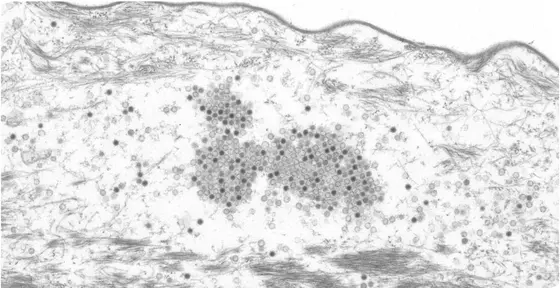The human immune system has a wide variety of defense strategies to protect the body against pathogens, one of which involves producing antibodies to fight viruses and bacteria. Over time, however, these pathogens have developed elaborate ways of escaping the immune system.
Scientists are already aware of some of these strategies. In human papillomaviruses (HPV), however, up until now they have only known about such strategies in innate, already present immunity and not in adaptive immunity, which does not develop until pathogens enter the body and is associated with the production of antibodies.
Frank Rösl and his co-workers from DKFZ under the supervision of Daniel Hasche have now discovered a new mechanism by which cutaneous papillomaviruses (specific to the skin) trick the immune system.
Certain cutaneous HPV, such as HPV5 and HPV8, occur as natural infections on the skin. They are not sexually transmitted, but are passed on from the mother to the newborn child. Thus, family members are usually colonized with the same HPV types. An infection normally goes unnoticed, because the body is able to overcome it. Depending on the individual status of a person's immune system, their genetic predisposition, age, and other external factors such as UV radiation, however, certain cutaneous HPV types are able to stimulate cell division in their host cells. This leads to skin changes and in rare cases to development of a squamous cell carcinoma, also known as fair-skin cancer.
The experiments were conducted in a particular mouse species, Mastomys coucha, which, like humans, can become infected with cutaneous papillomaviruses shortly after birth and produce specific antibodies against the virus. In combination with UV radiation, infected animals are more likely to develop squamous cell cancer.
The animals' immune system produces antibodies against the two viral proteins L1 and L2 that make up the virus particles, also called capsids. These antibodies can prevent the viruses from entering the host cells and thus neutralize the virus. However, the experiments carried out by the DKFZ scientists showed that besides the normal L1 protein, the viruses also produce a longer version. The latter is not able to actually take part in forming the viral capsid. Instead, it acts as a kind of bait against which the immune system directs its response and produces specific antibodies.
However, the scientists were able to demonstrate that these antibodies are not effective in fighting the papillomavirus. Instead of neutralizing the infectious pathogen through binding to L1, the antibodies merely bind the nonfunctional protein used as bait. While the immune system is busy producing these non-neutralizing antibodies, the virus can continue to replicate and spread throughout the body. It take several more months before neutralizing antibodies are produced that target the normal L1 protein and ultimately the infectious viruses themselves.
“In both rodents and humans, in almost all HPV types that can cause cancer, the L1 gene is designed such that a longer version of the protein can be produced. This is also true for high-risk HPV types such as HPV16 and HPV18, which can cause cervical cancer. It therefore appears to be a common mechanism that enables the viruses to replicate and spread efficiently during the early stage of infection“, Daniel Hasche explained. “The fact that antibodies against papillomaviruses can be detected is therefore not necessarily associated with protection against infection. This will need to be taken into account in future when evaluating and interpreting epidemiological studies,“ Frank Rösl added.
The present study was funded by the Wilhelm Sander Foundation (2018.093.1 and 2010.019.1), the German Federal Ministry of Education and Research (BMBF, 031L0095B), and the China Scholarship Council (CSC).
Yingying Fu, Rui Cao, Miriam Schäfer, Sonja Stephan, Ilona-Braspenning-Wesch, Laura Schmitt, Ralf Bischoff, Martin Müller, Kai Schäfer, Sabrina E. Vinzón, Frank Rösl and Daniel Hasche: Expression of different L1 isoforms of Mastomys natalensis papillomavirus as amechanism to circumvent adaptive immunity. eLife 2020, doi.org/10.7554/eLife.57626
A photo is available for download:
Striking-Image.jpg
Picture caption: Papillomaviruses in the stratum corneum of a skin tumor of a Mastomys coucha
Note on use of images related to press releases
Use is free of charge. The German Cancer Research Center (Deutsches Krebsforschungszentrum, DKFZ) permits one-time use in the context of reporting about the topic covered in the press release. Images have to be cited as follows: “Source: Michelle Neßling/DKFZ“.
Distribution of images to third parties is not permitted unless prior consent has been obtained from DKFZ's Press Office (phone: ++49-(0)6221 42 2854, E-mail: presse@dkfz.de). Any commercial use is prohibited.



